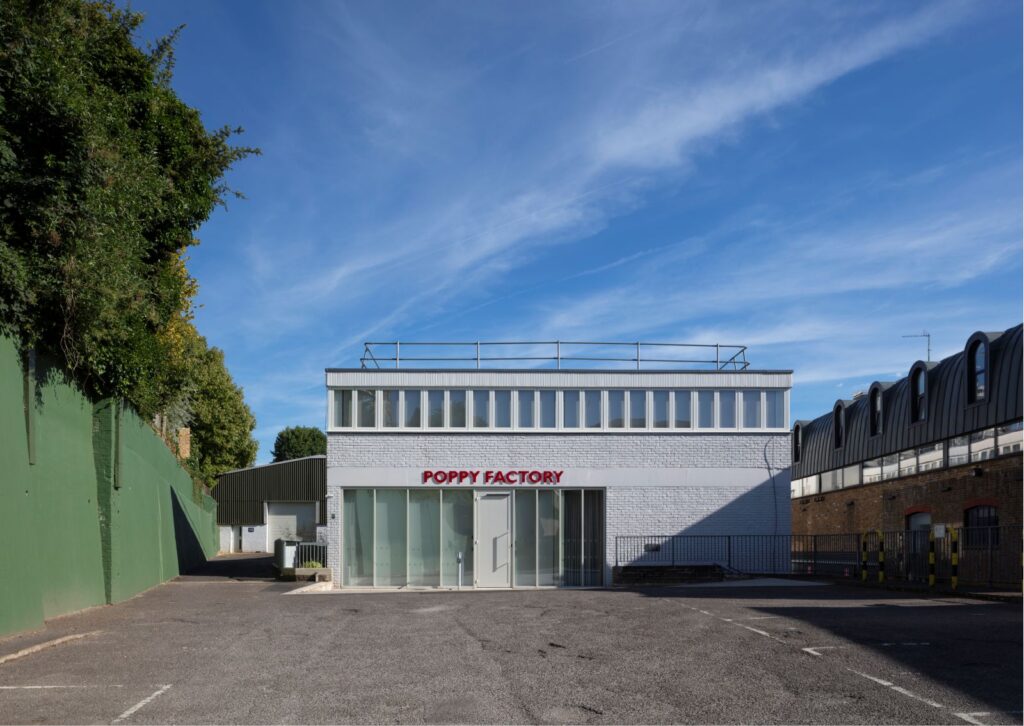The Poppy Factory by Henley Halebrown

The Poppy Factory is located in Richmond alongside the River Thames in South West London. It is a charity founded between the World Wars focused on identifying employment for veterans and raising funds for families affected by war.
The adaptive re-use project by Henley Halebrown has focused on expanding and reconfiguring existing visitor facilities and improving access as well as the overall working environment for employees, many of whom are veterans. These words from the poem celebrate a known phenomenon: the loss of one sense results in acuity in another.
Henley Halebrown are interested in how this phenomenon can be explored in their design for the Poppy Factory through the visceral possibilities of sensation, be that sight, hearing, smell or touch. For example, inside the project materials have been selected so that they absorb glare and are pleasant to touch and outside planting has been carefully chosen to encourage bird song and make for a fragrant garden.
The site
An important element of the new scheme for Poppy Factory is to bring together the existing buildings on the site thereby creating a campus and stronger sense of community. The self contained plot comprises of The Poppy Factory and a small 1930s housing estate built for factory workers with attractive enclosed verdant gardens. The estate continues to be resided by staff.
The Poppy Factory itself is made up of three buildings: its 1930s Art Deco style three-storey Factory; a single-storey warehouse; and a two-storey Brutalist 1970s brick block. These buildings house offices dedicated to finding employment for veterans and the poppy workshop with its adjacent warehouse.
Assistance-free design
Henley Halebrown’s design has linked these three buildings together and in doing so has deliberately united office and factory. This has been achieved with a combination of new ramped routes as well as a lift creating level access where floor heights currently vary by as much as 2.5m.
The ramps have been designed so that no grab rails are necessary thereby opting for a universally accessible design that is intuitive to use and clutter-free, giving everyone a better experience of the building.
Offices
The Poppy Factory offices are now in the former warehouse. Its remodelled interiors introduce new naturally ventilated and daylit office space within the existing lofty 7m high warehouse volume. The space is further transformed by the introduction of new skylights, and by opening up a façade to the prospect of the charity’s charming 1930s housing estate to the south.
The exceptionally high ceiling height in the offices together with its subtle top lighting make for a monumental and generous space that will not require mechanical cooling. Its semi-industrial rawness is retained and, together with the introduction of abundant natural light, the former warehouse has the feel of an external space, not unlike an atrium.
Workshop
The charity’s workshop remains in the original 1930s building with its specially designed benches for members of staff with restricted mobility. Adjacent to it, a part of the warehouse will be kept as storage for the poppies.
Public face
The Brutalist block at the front of the site continues to be used as the main entrance to The Poppy Factory. The offices it had housed have been replaced by new visitors’ facilities. The revisited block thus becomes the public face of the organisation, housing a new foyer, an exhibition space, an auditorium and a café (also used by staff).
Background
Inspired by Colonel John McCrae’s poem “In Flanders Fields”, the poppy became an icon of Remembrance in the wake of the First World War. In 2010, The Poppy Factory widened its expertise in employing injured ex-service personnel by helping veterans. The Poppy Factory continues to produce millions of hand-made paper poppies every year together with poppy wreaths and Remembrance symbols. Source by Henley Halebrown.
Photo © Nick KaneLocation: London, UKArchitect: Henley HalebrownProject architect: Elina DuekerProject Team: Gavin Hale-Brown, Simon Henley, Harry Insall-Reid, Michael Mee, Jennifer Pirie, Ami SkimmingAccess consultant: David Bonnett AssociatesStructural engineer: ArupServices engineer: ArupProject management: RealPMBuilding control: SocotecPlanning consultant: Gerald EveCost consultant: AlineaExhibition design: Samantha Heywood with Amanda ShephardExhibition design management: Alex Dunkley, Gardiner & TheobaldContract administration: Henley HalebrownContractor: Byrne GroupClient: The Poppy Factory with Stanhope as Client strategic advisorSize: 1,200m2Year: 2022Photographs: Nick Kane, Courtesy of Henley HalebrownPhoto © Nick KanePhoto © Nick KanePhoto © Nick KanePhoto © Nick KanePhoto © Nick KanePhoto © Nick KanePhoto © Nick KaneSectionPlan





